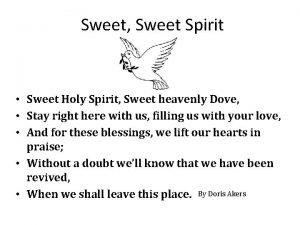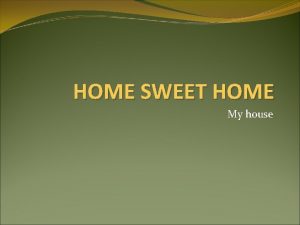Patrick Cudahy Training The Home of Sweet AppleWood












































- Slides: 44

Patrick Cudahy Training The Home of Sweet Apple-Wood Smoked Flavor. TM

overview • • • Welcome to Cudahy Patrick Cudahy Categories Pork 101 Pork Quality Ham training Ham terminology You Tube video Bacon Primal sheet Bacon Breakdown Sheet Glossary of Terms

Welcome To Cudahy, Wisconsin. Home Of Sweet Apple-Wood Smoked Flavor. • There’s no substitute for the small town values of Cudahy, Wisconsin. Perhaps that’s why there’s no mistaking the genuine goodness of Patrick Cudahy premium meats. • From our signature Sweet Apple-Wood Smoked bacon and ham to our premium deli meats, specialty meats and sausage, Patrick Cudahy stays true. True to the original recipes and rotary smokehouse created in 1888, still used to this day. • True to the good Midwestern people who demand that one-of-a-kind Patrick Cudahy flavor. True to the families and small town values that have been the cornerstone of our success for over a

The Man Who Built A Town Our founder, Patrick Cudahy, literally put the town of Cudahy on the map in 1892. An Irish immigrant born on St. Patrick’s Day and aptly named ‘Patrick’, he and his brother John grew up in Wisconsin and eventually turned good luck and hard work into a humble 700 acre parcel of land next to the railroad. The stop and the town were named “Cudahy” and from that day forward, began a legacy we respect with every product we make.

Still Made Right Here The families that settled in Cudahy, Wisconsin back in 1888 did so with little more than great faith in our founder, Patrick Cudahy. Those faithful families are the reason we still make it right. And why we’re still making history right here in Cudahy, Wisconsin.

Product Categories The Home of Sweet Apple-Wood Smoked Flavor. TM

Pepperoni We may be a few thousand miles away from the rustic villages of Italy, but our love for pepperoni is just as authentic. In true Patrick Cudahy fashion, we follow a century-old process that results in an irresistible selection of authentic Italian-style pepperoni. We use only the finest cuts of pork and beef, seasoned with artistry and then carefully cured and dried, slowly, the old world way.

Bacon Our one-of-a-kind taste, flavor and aroma is often imitated, but never duplicated. That’s because it’s been Sweet Apple-Wood Smoked the same way since 1888 – naturally, in our original fivestory smokehouse.

Smoked Ham When you craft perfection from the beginning, you leave well enough alone. That’s why we’ve made Patrick Cudahy Sweet Apple-Wood Smoked Hams the same way since 1888. That’s also why, for generations, families have reserved a special place on their tables for our signature hams. And because families just can’t get enough of that oneof-a-kind Patrick Cudahy flavor, we make our hams available in several delicious varieties.

Deli Meat It’s no wonder the Patrick Cudahy selection of deli meats are go-to classics. Our premium hams & turkeys are Sweet Apple-Wood Smoked for that unmistakable Patrick Cudahy flavor. And we make our salami, pepperoni and other European style dry sausages the Patrick Cudahy way – using old world recipes, authentic spices and seasonings and a century old process that stays true to the European traditions of the old country.

Breakfast Sausages Try new Patrick Cudahy All Natural Heat & Eat Sausage Patties and Links. Our new all natural recipe stays true to that unmistakable, sweet and smoky Patrick Cudahy flavor, available in convenient, fully-cooked and browned, heat & eat varieties. There’s no better way to start your day.

Pork 101 The Home of Sweet Apple-Wood Smoked Flavor. TM

Pork 101 All pork sold in supermarkets is either USDA inspected or inspected by state systems that follow standards set by the federal government. However, pork is not graded in the same way beef is graded. And while the pork cuts chart above doesn't show it, USDA grades for pork reflect only two levels: "Acceptable" grade and "Utility" grade. Acceptable grade pork is the only fresh pork sold in supermarkets. Pork graded as Utility is mostly used in processed products and is not available for consumer purchase. Now that we understand the grading, we'll discuss the best cuts of pork for grilling or BBQ. Let's start near the front of the hog, where the butt is located. . Huh? ?

Shoulder or boston Butt "Shoulder butt"? ? My girls laughed the first time I put that on our grocery list. And while it is odd-sounding, it's not what you might be thinking. In the pork cuts chart below, notice the shoulder area just beneath the "Clear Plate" portion of the hog. That is the upper portion of the shoulder. Depending on where you're from, this cut is known by several names, including: shoulder butt, pork butt, Boston Butt, Boston blade roast, Boston style shoulder, bone-inblade roast, boneless blade roast, blade end shoulder, and blade end butt. As you can see, it has nothing to do with the posterior of the hog, which is called the leg or ham.

Boston Butt The shoulder butt is a well-marbled cut, "marbling" being a food industry term for fat. Fat is good. Fat adds moisture and flavor. This makes the shoulder butt the cut of choice for your classic pulled-pork barbecue. Also, the shoulder butt is located "high on the hog", a term originally referring to the upper portion of the hog where you find your more expensive cuts. So when folk say "you're livin' high on the hog", that means you're living well! Therefore, the shoulder butt costs more than the picnic shoulder, which we'll discuss next.

Picnic Shoulder The picnic cut is the lower portion of the shoulder, closer to the foot. And while the butt can be bone-in or boneless, the picnic is most always bone-in with the skin left on. The picnic shoulder has more bone and is a little tougher. However, that is solved by "low and slow" cooking. Regarding taste, some say the picnic has a slightly different flavor than the butt -- that it's more like ham. Others prefer the picnic because it has a larger bone and meat closest to the bone is said to be more flavorful or "sweet". Picnic Shoulder Skin Side Up

Loin & chops As shown by the pork cuts chart, the loin runs from the hog's shoulder to hip. Above it is the back fat or "fatback", which can be used for salt pork, making lard, or added to ground pork or sausage. From the loin we get the leanest and most tender cuts. It is sold as roasts and chops, both with and without the bone.

Boneless Pork Loin Roast (Top) Boneless: The boneless pork loin roast comes from between the rib end and the sirloin end of the loin and is typically sold in 2 to 4 pound pieces. It is sometimes sold as a double boneless loin roast which is two boneless loin roasts tied together with the fat sides facing outward. Loin and loin roasts Pork Tenderloin Pork loin roast is not the same as pork tenderloin which is a long but smaller cut that usually weighs about a pound. There are three sections to a pork loin: Blade end. The meat is fattier at the shoulder, a. k. a. the blade end. Sirloin end. The meat is leaner at the rump, a. k. a. the sirloin end. It also has more bones. Center. This is the middle of the loin, where the meat is the most tender and most expensive. From these sections we get three major categories of pork chops: 1) Blade Chops, 2) Loin Chops, and 3) Sirloin Chops Let’s consider these in more detail.

Pork chops As you can see from the picture of the whole pork loin to the right, depending on their location on the loin, pork chops can get quite specific within the three major categories mentioned on the previous page. But one of the great things about pork chops is that they all cook the same. The only exception would be if you had a chop that was really thick or stuffed Other than that, all pork chops can be braised, grilled, broiled, or pan-fried. And since they are so easy to prepare, pork chops are probably the least intimidating cuts of pork if you're new to outdoor grilling. However, it is important to keep this one thing in mind: As with any lean cut of meat you must be careful not to overcook pork chops. Leaner cuts should not be cooked past medium (145°F).

Here's a quick run-down of things you'll likely find most helpful when selecting chops: Loin Chops: (a. k. a. pork loin end chop, pork center loin chop). These chops are sometimes sorted into loin and center loin, depending on how much tenderloin is attached. Loin chops have a T-shaped bone that's off to one side, like a pork T-bone. It has a New York cut on top and the fillet or tenderloin on the bottom. Blade Chops Cut from the beginning of the loin in the shoulder, they are usually thicker, more marbled, and a bit tougher than other chops. They can also withstand longer, slower cooking Sirloin Chops The sirloin chop is off the sirloin end of the pork loin. It has a little more bone than center cut chops but are of similar quality. Cook them as you would a loin chop. Rib Chops Rib chops are located next to the blade chops at the rib end of the loin. They include some back and rib bone. Top Loin Chop (No Picture) These chops are sometimes sold boneless and called pork loin fillets. There is no tenderloin attached and there is an outside layer of fat. These, too, can be grilled, broiled, or pan-fried. (a. k. a. pork strip chops, pork loin top loin chops).

Ribs, rib tips and belly • Ribs include; Baby Back Ribs, Spare Ribs, St. Louis Style Ribs and Country Style Rib Tips • Rib Tips are meaty but small rib pieces cut from the spare ribs. They contain few, if any ribs. • The Belly is where you find bacon and brisket.

Baby back ribs Baby Back Ribs Starting high on the hog first -- with baby back ribs. Baby back ribs are taken from the top of the pig's rib cage where the loin section is located. This is why they're sometimes called loin ribs or back ribs. Being from the loin, baby backs are smaller, less fatty and more tender than spare ribs.

Spare ribs are bigger, meatier, fatter, and thus more flavorful than baby backs. The Sparerib should contain at least 11 ribs and have enough lean coverage to eliminate bare bones. Taken from the belly section of the hog, they're also tougher and, therefore, take longer to cook. But, man, is it worth it! Spare ribs are one of the weapons of choice for pit masters at the competition level.

Spare ribs BBQ style The Sparerib BBQ Style is produced by removing the breast bone, or sternum from the Sparerib.

St. louis style ribs St. Louis style ribs or St. Louis cut (SLC) are spare ribs with the brisket bone (rib tips) and flap meat removed. Some cooks prefer their ribs trimmed this way because of appearance, allowing you to serve more even portions. More importantly, it helps the ribs cook more evenly.

Rib tips are meaty but small rib pieces cut from the spare ribs when you're trimming your slab St. Louis style. Country Style Spare Ribs Also known as pork country ribs, country spareribs, and country style ribs, these ribs are not really ribs at all. Although you can't see it in the pork cuts chart, they're cut from the blade end of the loin, next to the shoulder. However, they contain few, if any ribs. As mentioned earlier, meat next to shoulder is more fatty. So these ribs have a high fat content which keeps the moist and tender with lots of flavor. They're great on the grill using the low and slow, indirect heat method.

Quality standards

Ham training The Home of Sweet Apple-Wood Smoked Flavor. TM

What is Ham? At the most basic level, a ‘ham’ refers to a specific cut of pork, not how it’s cured or cooked. A ham comes from the back thigh/rump of a pig so this means there are just two per animal. Imagine where the ‘hams’ are on your own body, it’s the same.

WHOLE HAM A whole ham will typically weigh 18 to 20 pounds and includes both the ‘butt’ end and the ‘shank’ end. The ‘butt end’ is the upper part of the ham, more ‘rump’ and thus more fatty. The ‘shank end’ is the lower end, more leg and less fatty. The shank end has just one bone so is easier to slice. When I cooked half a ham recently, a nine-pound bone-in, shankend ham yielded nearly eight pounds of cooked ham meat. Some hams will still have a thick layer of fat on the exterior (this is what gets scored in diamond shapes for an attractive look once the ham is baked and reaches the table); some producers leave a thin layer of fat, there’s still enough for scoring.

Definition - The word HAM means pork which comes from the hind leg of a hog. Ham made from the front leg of a hog will be labeled "pork shoulder picnic".

Hams are either ready-to-eat or not. Ready-to-eat hams include prosciutto and fully cooked hams; they can be eaten right out of the package. Fresh hams must be cooked by the consumer before eating.

Hams may be fresh, cured, or cured-and-smoked. The usual color for cured ham is deep rose or pink: Dry Cured Ham This ham is cured by burying it in a mound of salt or by rubbing the skin with salt. It is usually hung and air-dried for 6 to 18 months at cool temperatures allowing for dehydration and concentration of flavors. Often a dry cured ham is smoked at low temperatures to help enhance the flavor.

Hams may be fresh, cured, or cured-and-smoked. The usual color for cured ham is deep rose or pink: Fresh Ham: A raw uncured rear leg of a pig. The cut usually comes with the skin still on. The meat is typically pale pink to beige (the color of raw pork). Since the meat is not cured or smoked, it has the flavor of a fresh pork loin roast or pork chops. Its raw color is pinkish red and after cooking, grayish white.

These last three must all declare the amount of additives to the product label. Industry standard is 10%, 35% & 39% Ham with natural juices: has a bit of water added during the curing process, making it velvety in texture. This ham is most often chosen to star in holiday meals. Water-added ham: extra juicy, which makes it great for ham steaks. Leftovers are perfect for slicing or shaving into sandwiches. Ham-and-water product: the least expensive option, contains the most water, which reduces its fat and protein content. It’s best for slicing and shaving.

Bacon and bacon processing The Home of Sweet Apple-Wood Smoked Flavor. TM

mmm…bacon

BElly The Rib Belly is separated from the loin and contains the Spare Rib. Common weight range is between 10 -17 lbs. This is a skin on belly with the rib removed. Common weight range is 10. 5 lbs. and below. This is a skinless belly with rib removed.

Belly anatomy Skirt Meat Teat Side “Blue” Flank Ham End Shoulder End Primary Lean Secondary Lean Loin Side Lean Belly Trim Secondary Lean

Bacon process Injected Belly: Pumped with 11% cure Smoked Belly: Cooked at 127 degrees for 8 hours Pressed Belly: Specified dimensions to ensure consistent slicing

Types of bacon Layout Bacon: Individual slices laid flat on a sheet, 10 -11 slices per sheet, usually 8 -9. 25 inches in length Shingle Bacon: 3 layers of sliced bacon, 5 lbs per layer and sliced to a specific slice count per pound. 8 -10. 5 inches in length Slab Bacon: 3 layers of sliced bacon 5 pounds per layer and sliced to a specific thickness. Around 9. 25 inches in length

Glossary of terms The Home of Sweet Apple-Wood Smoked Flavor. TM

Glossary page 1

Glossary page 2
 Applewood heights hoa
Applewood heights hoa Flower plural
Flower plural Go to my house
Go to my house Arman home sweet home
Arman home sweet home Home sweet home survive items
Home sweet home survive items Sweet heavenly dove
Sweet heavenly dove Earths biomes
Earths biomes Sweet home lesson
Sweet home lesson Pengertian homecare
Pengertian homecare Perbedaan home care dan home visit
Perbedaan home care dan home visit Mobile home exchange
Mobile home exchange Come home come home jesus is calling
Come home come home jesus is calling Oak springs mobile home park
Oak springs mobile home park She said that, home economics stands for the ideal home.
She said that, home economics stands for the ideal home. Hình ảnh bộ gõ cơ thể búng tay
Hình ảnh bộ gõ cơ thể búng tay Bổ thể
Bổ thể Tỉ lệ cơ thể trẻ em
Tỉ lệ cơ thể trẻ em Chó sói
Chó sói Tư thế worm breton là gì
Tư thế worm breton là gì Hát lên người ơi alleluia
Hát lên người ơi alleluia Môn thể thao bắt đầu bằng từ đua
Môn thể thao bắt đầu bằng từ đua Thế nào là hệ số cao nhất
Thế nào là hệ số cao nhất Các châu lục và đại dương trên thế giới
Các châu lục và đại dương trên thế giới Công thức tính thế năng
Công thức tính thế năng Trời xanh đây là của chúng ta thể thơ
Trời xanh đây là của chúng ta thể thơ Mật thư anh em như thể tay chân
Mật thư anh em như thể tay chân Làm thế nào để 102-1=99
Làm thế nào để 102-1=99 Phản ứng thế ankan
Phản ứng thế ankan Các châu lục và đại dương trên thế giới
Các châu lục và đại dương trên thế giới Thơ thất ngôn tứ tuyệt đường luật
Thơ thất ngôn tứ tuyệt đường luật Quá trình desamine hóa có thể tạo ra
Quá trình desamine hóa có thể tạo ra Một số thể thơ truyền thống
Một số thể thơ truyền thống Cái miệng nó xinh thế
Cái miệng nó xinh thế Vẽ hình chiếu vuông góc của vật thể sau
Vẽ hình chiếu vuông góc của vật thể sau Thế nào là sự mỏi cơ
Thế nào là sự mỏi cơ đặc điểm cơ thể của người tối cổ
đặc điểm cơ thể của người tối cổ Thứ tự các dấu thăng giáng ở hóa biểu
Thứ tự các dấu thăng giáng ở hóa biểu Vẽ hình chiếu đứng bằng cạnh của vật thể
Vẽ hình chiếu đứng bằng cạnh của vật thể Tia chieu sa te
Tia chieu sa te Thẻ vin
Thẻ vin đại từ thay thế
đại từ thay thế điện thế nghỉ
điện thế nghỉ Tư thế ngồi viết
Tư thế ngồi viết Diễn thế sinh thái là
Diễn thế sinh thái là





























































